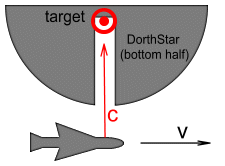The Lorentz Transform
Where v is velocity of an object, c is the speed of light and γ is a multiplier factor that can be applied to attributes such as distance, mass and time. In this chapter I will give a derivation for the Lorentz Transform. This is a more entertaining derivation than what’s commonly found in science texts but it uses the same vector calculations and thus yields the same results.
The Hit Man’s DilemmaSuppose that a crime gang had a problem that needed solving. The ‘problem’ was in the form of a competitor from a rival gang and ‘solving’ it required the services of a hit man. Now it so happened that this competitor did not make himself easily accessible and only ventured out at a certain time of every day for a smoke. He stood at the front of a building that was protected from the main road by a brick wall with an opening in it. See below diagram.
The hit man decided that the only way to do the job was via a drive-by
shooting. But he had three problems to surmount:
Here we can see that while the bullet moves at full speed relative to the car, it will hit its target at slightly less than full speed. Let vh be the velocity at which the bullet hits its target. Using pythagoras we see that:
In other words the hit speed vh will steadily decrease as the car’s velocity vc increases, and will become zero when the car moves as fast as the bullet.
A Star Wars DilemmaNow fast forward to the future. Our hero Lube Skystalker has been sent on a mission to destroy the evil DorthStar planet. For this mission he will need to fly past the planet’s entrance and shoot a powerful laser beam into its innards. See below diagram.
Lube faces the same challenge as the hit man in the earlier example, namely that he will need to compensate for his space-ship’s forward movement in order to aim the beam at the target. Let v be the velocity of the ship and c be the speed of the light from the laser gun. How fast will the laser beam hit its target? Using the same method as with the previous example we get:
Where c2 is the velocity of the light at the
target.
This ratio can be used to multiply the time-sensation of the target so that it will perceive the beam to be moving at the normal speed of light. This factor, or rather its inverse (for some reason it’s expressed in the reciprocal form), is known as the Lorentz Transform factor γ namely:
From the above equation we can see that γ has a value of one when velocity is
zero, and moves toward infinity as velocity approaches the speed of light. For example
when the velocity is 50% of light speed, γ
has a value of 1.15; at 90% of light speed, γ
has a value of 2.3; and at 99.5% of light speed, γ
has a value of 10. This means that at 50% the time-sensation at the target will be 13%
slower; at 90% it will be 2.3 times slower and at 99.5% it would be 10 times slower than
the source. |





